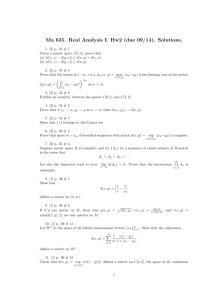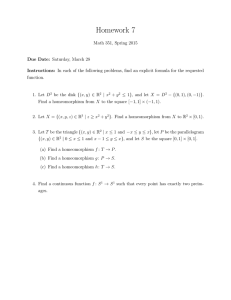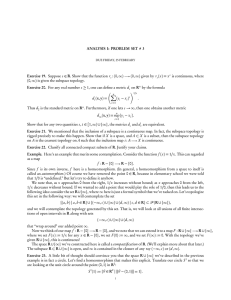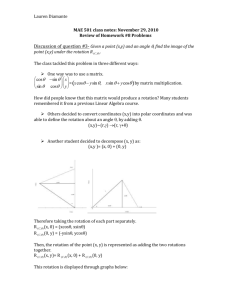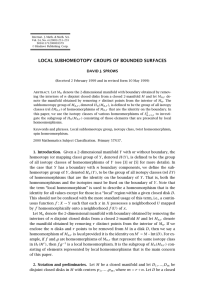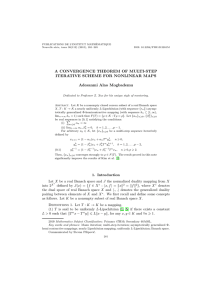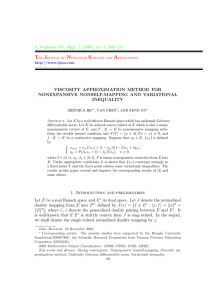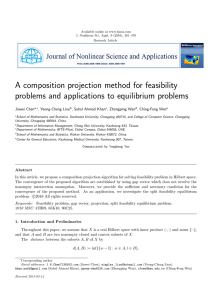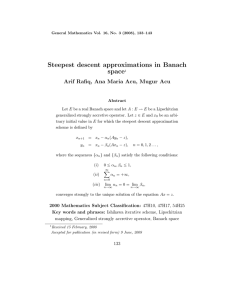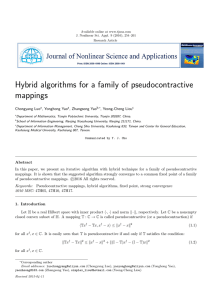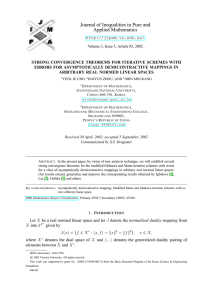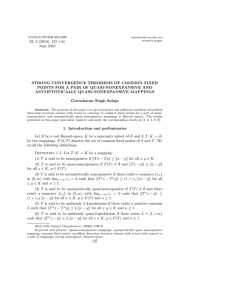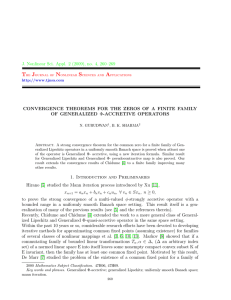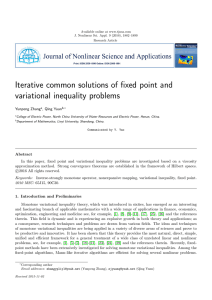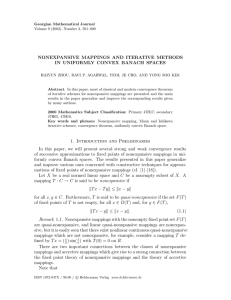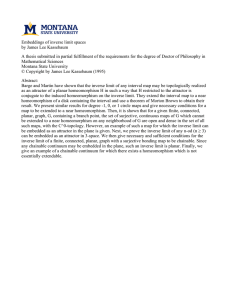Hw4-solutions - personal.stevens.edu
advertisement
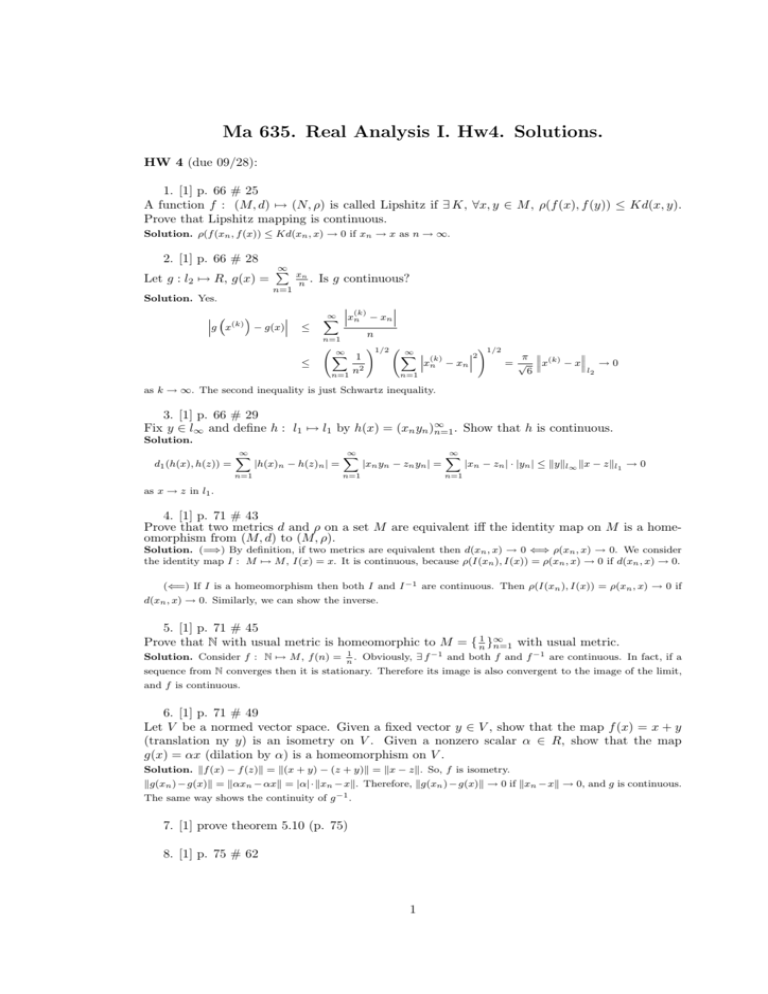
Ma 635. Real Analysis I. Hw4. Solutions.
HW 4 (due 09/28):
1. [1] p. 66 # 25
A function f : (M, d) 7→ (N, ρ) is called Lipshitz if ∃ K, ∀x, y ∈ M , ρ(f (x), f (y)) ≤ Kd(x, y).
Prove that Lipshitz mapping is continuous.
Solution. ρ(f (xn , f (x)) ≤ Kd(xn , x) → 0 if xn → x as n → ∞.
2. [1] p. 66 # 28
Let g : l2 7→ R, g(x) =
Solution. Yes.
∞
P
n=1
g x(k) − g(x)
xn
n .
≤
Is g continuous?
∞ x(k)
X
n − xn n=1
≤
∞
X
1
2
n
n=1
n
!1/2
∞ 2
X
(k)
xn − xn n=1
!1/2
π = √ x(k) − x → 0
l2
6
as k → ∞. The second inequality is just Schwartz inequality.
3. [1] p. 66 # 29
Fix y ∈ l∞ and define h : l1 7→ l1 by h(x) = (xn yn )∞
n=1 . Show that h is continuous.
Solution.
d1 (h(x), h(z)) =
∞
X
|h(x)n − h(z)n | =
n=1
∞
X
|xn yn − zn yn | =
n=1
∞
X
|xn − zn | · |yn | ≤ kykl∞ kx − zkl1 → 0
n=1
as x → z in l1 .
4. [1] p. 71 # 43
Prove that two metrics d and ρ on a set M are equivalent iff the identity map on M is a homeomorphism from (M, d) to (M, ρ).
Solution. (=⇒) By definition, if two metrics are equivalent then d(xn , x) → 0 ⇐⇒ ρ(xn , x) → 0. We consider
the identity map I : M 7→ M , I(x) = x. It is continuous, because ρ(I(xn ), I(x)) = ρ(xn , x) → 0 if d(xn , x) → 0.
(⇐=) If I is a homeomorphism then both I and I −1 are continuous. Then ρ(I(xn ), I(x)) = ρ(xn , x) → 0 if
d(xn , x) → 0. Similarly, we can show the inverse.
5. [1] p. 71 # 45
Prove that N with usual metric is homeomorphic to M = { n1 }∞
n=1 with usual metric.
1
Solution. Consider f : N 7→ M , f (n) = n
. Obviously, ∃ f −1 and both f and f −1 are continuous. In fact, if a
sequence from N converges then it is stationary. Therefore its image is also convergent to the image of the limit,
and f is continuous.
6. [1] p. 71 # 49
Let V be a normed vector space. Given a fixed vector y ∈ V , show that the map f (x) = x + y
(translation ny y) is an isometry on V . Given a nonzero scalar α ∈ R, show that the map
g(x) = αx (dilation by α) is a homeomorphism on V .
Solution. kf (x) − f (z)k = k(x + y) − (z + y)k = kx − zk. So, f is isometry.
kg(xn ) − g(x)k = kαxn − αxk = |α| · kxn − xk. Therefore, kg(xn ) − g(x)k → 0 if kxn − xk → 0, and g is continuous.
The same way shows the continuity of g −1 .
7. [1] prove theorem 5.10 (p. 75)
8. [1] p. 75 # 62
1
9. [1] p. 94 # 13
Show that¯ R endowed
with the metric ρ(x, y) = | arctan x − arctan y| is not complete. How about
¯
τ (x, y) = ¯x3 − y 3 ¯?
10. [1] p. 94 # 14 ¯
¯
1
− n1 ¯ for m, n ∈ N , show that d is equivalent to the usual metric on N
If we define d(m, n) = ¯ m
but (N, d) is not complete.
11. [1] p. 94 # 19
Show that c0 is closed in l∞ .
(n) − xk
Solution. Let {x(n) }∞
∞ = 0. By the definition
n=1 ⊂ c0 is a converging (in l∞ ) sequence to x: lim kx
n→∞
of limit, this means that
∀ε > 0 ∃N ∀n > N :
sup
1≤k≤∞
(n)
|xk
− xk | < ε.
(1)
From (1) we obtain the coordinate-wise convergence x(n) → x, n → ∞. Since ∀ n, x(n) ∈ c0 , then
(n)
∀ n ∃K = K(n) ∀k > K, |xk | < ε.
(2)
(n)
In view of (1), for an arbitrary ε > 0 we pick up N such that for all n > N and all k, |xk
− xk | < ε/2. After
(n )
that, we fix any n0 > N and find K (depending on n0 and ε) such that from (2) ∀k > K, |xk 0 | < ε/2.
(n )
(n )
Finally, |xk | ≤ |xk 0 − xk | + |xk 0 | < 2ε + 2ε = ε subject to k > K. This implies xk → 0 as k → ∞ and,
hence, x ∈ c0 . Then c0 is closed in l∞ .
12. [1] p. 94 # 20
13. [1] p. 94 # 21
14. [1] p. 102 # 42
Rx
Define T : C[0, 1] 7→ C[0, 1] by T f (x) = 0 f (t)dt. Show that T 2 is a contraction. What is its
fixed point?
R2
15. To solve equation f (x) = λ 0 (x + y)f (y)dy, we consider f ∈ C[0, 2] and
R2
F (f )(x) = 1 + λ 0 (x + y)f (y)dy. Find λ at which F : C[0, 2] 7→ C[0, 2] is contractive. For
initial value f (x) = 0 perform 3 iterations to approach the solution f (x).
(!) Please read the corresponding sections of the textbook.
References
[1] Carothers N.L., Real Analysis. Cambridge University Press, 2000.
ISBN 0521497493 or ISBN 0521497566.
[2] Kolmogorov, A.N., and Fomin, S.V., Introductory Real Analysis. Dover, 1970.
ISBN 0486612260.
[3] Haaser, N.B., and Sullivan, J.A., Real Analysis. Dover, 1991.
ISBN 0486665097.
[4] Rudin, W., Real and Complex Analysis, 3d ed. McGraw-Hills, 1987.
[5] Folland, G.B., Real Analysis. Wiley, 1984.
[6] Reed, M. and Simon, B., Methods of Modern Mathematical Physics. 1. Functional Analysis.
Academic Press 1972.
2
[7] Oxtoby, J.C., Measure and Category. A survey of the Analogies between Topological and
Measure Spaces. Springer-Verlag, 1971.
3
